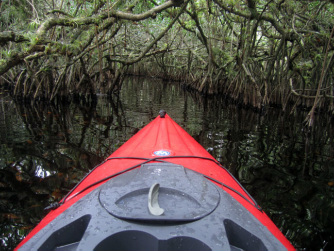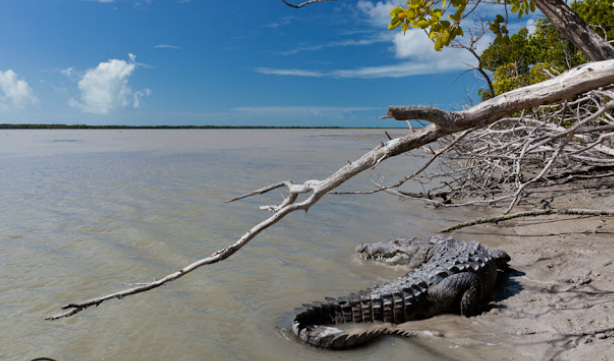Kayaking "The Big Cypress" with Crocodiles
Image courtesy of Mack Stone Photography
My wife Cindy and I were finishing up the last leg of a kayaking adventure in the Big Cypress National Preserve in the Florida Everglades. As we came close to shore, I spotted a shape moving just beneath the surface of the water. It was about ten-feet long and a light brownish/green color, similar to that of a manatee, but with a narrower girth. I was pretty sure that it wasn't an alligator, although they’re everywhere in the Everglades. The color was wrong; alligators that size are almost completely black and essentially invisible in darker water. We had seen an eight footer only a few hundred yards back nestled in the mangroves and slowed down to look, but then paddled on. Alligators are so abundant in Florida that seeing one generally causes no real concern. At least not your average-sized gator, which tends to be in the six- to eight-foot range and probably about 150 to 200 Lbs. Anything approaching ten feet or larger, however, is another matter.
Once I had eliminated the probability of a gator or manatee, the only thing close to the shape and color swimming within a few yards of our Kayaks was a crocodile. On the shore was an older Hispanic couple fishing, I yelled to them, “Did you see what that was in the water”? The woman responded, “It was a crocodile”! Knowing how rare crocs are outside of the southernmost tip of the Everglades, I thought she'd probably misidentified an alligator, although, in the back of my mind, I knew the color was wrong. I shouted back, “You mean a gator”? Without hesitation, she said, “No, it was a crocodile”!
My initial reaction was mixed; I knew that there’d been no verified crocodile attacks on humans in Florida since the early part of the 20th Century; even then, the lone fatality was due to a provoked attack. There was one unverified incident with a couple of young kayakers a few years ago. But most scientists determined that the probability that it was a crocodile was slim.
Croc’s in Florida fairly regularly attack and eat dogs unfortunate enough to come within range, this includes some very big dogs like German Shepherds. These occurrences aren't always in rural areas either, but are frequently in suburban areas like the historic upscale neighborhood of Coral Gables in Miami. Croc sightings outside of South Florida, however, are rare. I’d asked a number of people who live in Everglades City, which is a fair distance from their normal habitat, if they’d ever seen any in the area, all of them said no. Although, they did say there was at least one in the area that had been spotted by others.
Once I had eliminated the probability of a gator or manatee, the only thing close to the shape and color swimming within a few yards of our Kayaks was a crocodile. On the shore was an older Hispanic couple fishing, I yelled to them, “Did you see what that was in the water”? The woman responded, “It was a crocodile”! Knowing how rare crocs are outside of the southernmost tip of the Everglades, I thought she'd probably misidentified an alligator, although, in the back of my mind, I knew the color was wrong. I shouted back, “You mean a gator”? Without hesitation, she said, “No, it was a crocodile”!
My initial reaction was mixed; I knew that there’d been no verified crocodile attacks on humans in Florida since the early part of the 20th Century; even then, the lone fatality was due to a provoked attack. There was one unverified incident with a couple of young kayakers a few years ago. But most scientists determined that the probability that it was a crocodile was slim.
Croc’s in Florida fairly regularly attack and eat dogs unfortunate enough to come within range, this includes some very big dogs like German Shepherds. These occurrences aren't always in rural areas either, but are frequently in suburban areas like the historic upscale neighborhood of Coral Gables in Miami. Croc sightings outside of South Florida, however, are rare. I’d asked a number of people who live in Everglades City, which is a fair distance from their normal habitat, if they’d ever seen any in the area, all of them said no. Although, they did say there was at least one in the area that had been spotted by others.

When we began our kayak trip in the Big Cypress, I recounted to my wife how three experienced travelers kayaking in an isolated region of Africa populated with hippos and large Nile crocodiles, had been attacked by a massive croc. Without breaking a ripple, the animal moved into the narrow space between the three men who were rowing in a V formation and attacked their guide, one of the most experienced and knowledgeable adventurers in world, and then submerged before his two companions could react. His body was never found. She looked at me in mid stroke and said, “Did you really need to tell me this story right now”? Thinking better of it, I quickly changed subjects.
By the end of trip, in that moment as the large shape passed by, I realized just how vulnerable we really were. Crocodiles and alligators are almost purely instinctive, and there was no guarantee that if the animal brushed close enough, causing us to panic, that we wouldn't be plunged into the black, brackish water with one of natures most feared and perfectly designed predators.
And with that, we paddled the remaining few hundred yards to the end of our journey with a better sense of our circumstance, appreciating the stunning beauty of the natural world, with a healthy respect for its potential dangers intact.
Mark Magula
By the end of trip, in that moment as the large shape passed by, I realized just how vulnerable we really were. Crocodiles and alligators are almost purely instinctive, and there was no guarantee that if the animal brushed close enough, causing us to panic, that we wouldn't be plunged into the black, brackish water with one of natures most feared and perfectly designed predators.
And with that, we paddled the remaining few hundred yards to the end of our journey with a better sense of our circumstance, appreciating the stunning beauty of the natural world, with a healthy respect for its potential dangers intact.
Mark Magula
|
|
|
